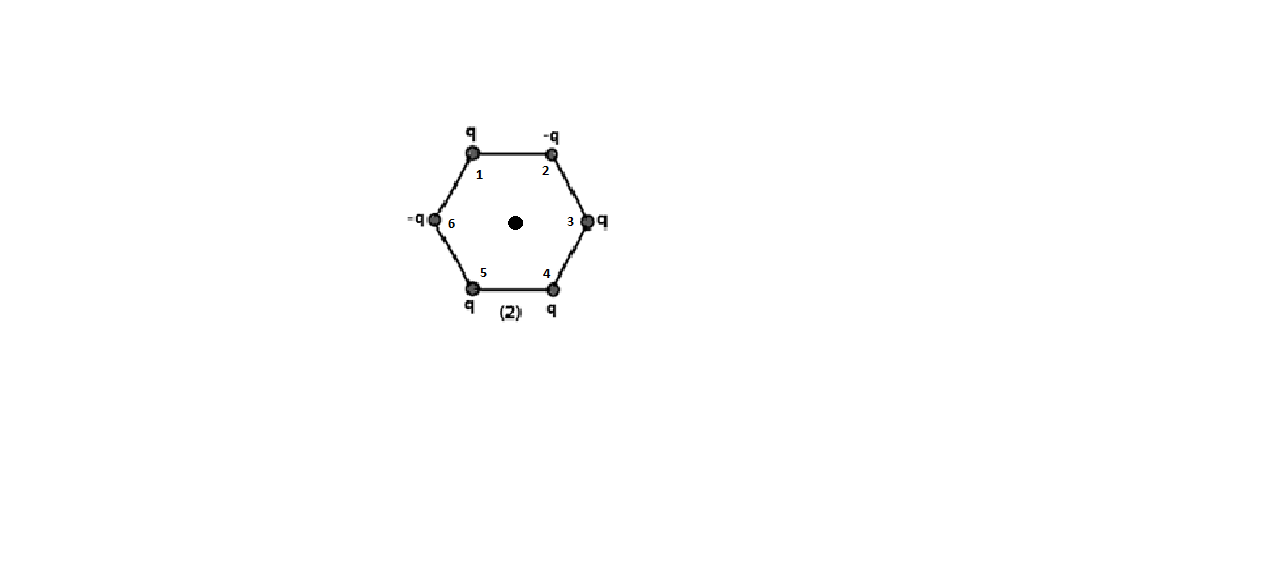
The figure below shows regular hexagons, with charges at the vertices. In which of the following cases the electric field at the center is not zero.

A) $4$
B) $3$
C) $1$
D) $2$
Answer
146.7k+ views
Hint: At the center of every hexagon, the electric field is zero. Here, the electric field will be zero because the charges of the same values with opposite charges will terminate each other i.e. \[{\text{ + q}}\] and \[{\text{ - q}}\] in each corner cancel out each other.
Complete step by step answer:
The charge at the position $1$ and the charge at the position $4$ cancel each other.
Whereas, the charges at positions $2$ , $5$ , and $3$ , $6$ will not cancel each other.

The magnitude of the electric field \[\left( E \right)\]occurred by a point charge with a charge of magnitude \[Q\] , at some distance $r$ away from the point charge, is given by the equation \[E = \dfrac{{k{\text{Q}}}}{{{r^2}}}\].
Where \[k = 8.99 \times {10^9}{\text{ N }}\dfrac{{{{\text{m}}^2}}}{{{c^2}}}\].
Hence, the right answer is in option $(D) \Rightarrow 2$ .
Additional information:
The electric field is outlined as the electric force per unit charge. The direction of the field is taken to be the direction of the force it might exert on a positive test charge. The electric field is radially outward from a positive charge and in toward a negative charge.
Note: Electric fields allow all things electrical to operate from the simple flashlight to the light switch you turn on when you enter a room and all the way on up to every single device using any form of electricity or Electronics including every computer, smartphone, radio, television, auto, airplane, and many medical advances.
Complete step by step answer:
The charge at the position $1$ and the charge at the position $4$ cancel each other.
Whereas, the charges at positions $2$ , $5$ , and $3$ , $6$ will not cancel each other.

The magnitude of the electric field \[\left( E \right)\]occurred by a point charge with a charge of magnitude \[Q\] , at some distance $r$ away from the point charge, is given by the equation \[E = \dfrac{{k{\text{Q}}}}{{{r^2}}}\].
Where \[k = 8.99 \times {10^9}{\text{ N }}\dfrac{{{{\text{m}}^2}}}{{{c^2}}}\].
Hence, the right answer is in option $(D) \Rightarrow 2$ .
Additional information:
The electric field is outlined as the electric force per unit charge. The direction of the field is taken to be the direction of the force it might exert on a positive test charge. The electric field is radially outward from a positive charge and in toward a negative charge.
Note: Electric fields allow all things electrical to operate from the simple flashlight to the light switch you turn on when you enter a room and all the way on up to every single device using any form of electricity or Electronics including every computer, smartphone, radio, television, auto, airplane, and many medical advances.
Recently Updated Pages
How to find Oxidation Number - Important Concepts for JEE

How Electromagnetic Waves are Formed - Important Concepts for JEE

Electrical Resistance - Important Concepts and Tips for JEE

Average Atomic Mass - Important Concepts and Tips for JEE

Chemical Equation - Important Concepts and Tips for JEE

Concept of CP and CV of Gas - Important Concepts and Tips for JEE

Trending doubts
JEE Main 2025 Session 2: Application Form (Out), Exam Dates (Released), Eligibility, & More

JEE Main Exam Marking Scheme: Detailed Breakdown of Marks and Negative Marking

JEE Main 2025: Derivation of Equation of Trajectory in Physics

Electric Field Due to Uniformly Charged Ring for JEE Main 2025 - Formula and Derivation

JEE Main Participating Colleges 2024 - A Complete List of Top Colleges

Degree of Dissociation and Its Formula With Solved Example for JEE

Other Pages
JEE Advanced Marks vs Ranks 2025: Understanding Category-wise Qualifying Marks and Previous Year Cut-offs

JEE Advanced 2025: Dates, Registration, Syllabus, Eligibility Criteria and More

JEE Advanced Weightage 2025 Chapter-Wise for Physics, Maths and Chemistry

Electric field due to uniformly charged sphere class 12 physics JEE_Main

Learn About Angle Of Deviation In Prism: JEE Main Physics 2025

Ideal and Non-Ideal Solutions Raoult's Law - JEE




